France Bordelais
EN PRIMEUR WINE SALES: A PRECISION MECHANISM
The character of the 2011 vintage
En Primeur wine sales, not to be confused with the sale of young wines, often called ‘primeurs’, is a tradition typical of the Bordeaux wine-growing region. Although there are a few similar initiatives in other wine areas, they are modest compared to the practice in the Gironde, which has become a veritable institution. The concept is perfectly summed up in the English translation: ‘to buy futures’. These wines are in fact intended to be kept for ageing.
Genesis, from oral tradition to institution…
The historian Antoine Lebègue, author of numerous books about Bordeaux and its wines, and President of the Vins de la Mémoire de Bordeaux group, describes the genesis of the En Primeur system: “
An oral tradition that began in the 19th century, then at the beginning of the 20th, the idea of wine traders taking out a “subscription” with a well-known wine estate was mentioned. Good relations between gentlemen, when the wine trader would set off in a horse-drawn carriage to visit the Médoc wine estates and taste the wines. There were no written contracts, but a purely oral tradition and ordinary decency were the order of the day. The system gradually and empirically gravitated towards a structure with three protagonists: the wine owner, the broker and the wine trader. From the 1950s, order was introduced and the idea of allocations granted by the Châteaus to the traders emerged. The oral tradition persisted among the three players”.
From tradition to precision mechanism…*
“
After a difficult period for the Bordeaux vineyards (two world wars and the freeze of 1956) the system started to establish itself as an organisation in 1970, with a vintage of good quality, and the growing American interest in the wines. From 1972, price quotations began to be organised. In the 1980s, the ‘81, ‘82 and ‘83 vintages, the organisation of futures tasting, the arrival of Robert Parker, an American wine critic, and journalists from the Hachette wine guide (founded in 1984) were the catalysers. From oral tradition, contracts between estates, brokers and traders became de rigueur”, A. Lebègue explains.
The informal gentleman’s agreement gave way to the institutional dimension. The 1990s were speculative, driven by interest on the part of the Japanese. From 2000, a succession of excellent vintages, media coverage, social networks, Web magazines, China becoming the leading market for Bordeaux wines and the lucrative wine auctions in Asia intensified speculation involving around forty wines in 2009 and 2010.
The En Primeur sale system is based on the expectation that the prices will increase over time, with three key periods: tasting, the publication of the evaluations and the announcement of the prices of the wines. The mechanism consists in putting the wines of the latest vintage on the market for Bordeaux brokers and traders in the spring following the harvest. The estates decide on the dates and after the tasting of the En Primeurs, produce an initial offering price for the Bordeaux wine trade. The tasting takes place on average over a period of three to four weeks, with the most important week at the beginning of April, from 2 - 6 April in 2012. Journalists, buyers, distributors, traders and brokers give their opinion on the quality of the representative samples of the vintage. The actual delivery only takes place when the wine is bottled, some 18 to 24 months after the transaction.
This year, the spotlight is on the 2011 vintage, which is trying to establish its place after two dates about which much was said and written… 2009 and 2010.

Stéphane Toutoundji 
Valérie Lavigne
A reminder of rather unusual weather conditions.
After the 2008, 2009 and 2010 series, the latest in the line, the 2011 vintage, experienced weather conditions that were out of the ordinary. The task of the vineyard workers was complicated by a period of summer weather in springtime, unaccustomed precocity, a deficit of sunshine in July, a month of August that was cooler and wetter than average and then a second summer at the beginning of the autumn.
The 2011 vintage was far from easy: an early lack of rain, stormy episodes, hailstones on some vineyards, renewed growth in the plants after the ripening process had begun, and slow, uneven ripening of the grapes. These facts demanded close observation of the vineyard plots, and exceptional adaptation and sorting (particularly on red wine grapes).
SommelierS International covered more than 3,500 km in three weeks to taste almost 550 wines. The sweet white wines present a quality almost on a par with the splendid 2001 vintage. For Sauternes and Barsac, harvested in a small number of sorting operations due to the rapid effect of the ‘botrytisation’, there was genuine enthusiasm at the tastings and some great wines were discovered. In whites, the expression of the Sauvignon is frank, with good acidity, delicate, aromatic, and of very good quality.

Concerning the reds, we asked for a more in-depth analysis in this introduction from Valérie Lavigne, a consultant in charge of research for Tonnellerie Seguin-Moreau, seconded to the Faculty of Oenology at Bordeaux University (I.S.V.V), and Stéphane Toutoundji, œnologist/consultant.
“
More sensitive to the violence of the weather than the Cabernets (excessive drought and heat in June, higher than average rainfall in August), the 2011 Merlots are of a somewhat mixed quality. The best wines were grown on the clay slopes and limestone soils of the right bank. On these grands terroirs of Merlot, the deeply coloured, fruity wines are unctuous, full of relief and a freshness that is lacking in the wines grown on gravely soils, which don’t have the same moisture reserves.
The ripening of the Cabernets was much more homogenous, with the exception of a few very young wines on dry gravel soil which were subjected to excessive spring water stress. The small, deeply coloured and tannic grapes, generally devoid of vegetation-type character, yielded wines that are dense, powerful and fresh. The loss of yield caused by the extreme temperatures at the end of June (above 40°C) reinforced the tannins and concentrated character, resulting in occasionally austere wines at this stage of the maturing process.
Although produced early, the wines of 2011 do not possess the analytical characteristics of an early vintage. They have less alcohol content and a significantly lower pH than the 2009 and 2010 wines and the most successful among them have the structure to be able to age well. 2011 is certainly a mixed vintage for reds, but comprises some real successes”, Valérie Lavigne explains to us.
“
We cannot truly say one bank is better than the other after this period of tasting the En Primeurs. The choice of dates for the harvests, sorting, vinification, extraction, the woody undertones and wine varieties were critical to the success of this vintage. Given the unusual conditions in 2011, it must be said that the Cabernet grape varieties and the Cabernet Franc in particular, fared very well. The decisions taken regarding work done in the vineyard, and human intervention were two decisive factors in this success: a vintage that was very exacting in the vineyard and very technical in the wine cellar. For this vintage, the purity of the fruit had to be given preference and conserved with delicate, mellow and stylish woody undertones (maturation). A lot of lessons were learnt in 2011, and much thought given to the vines, vinification and woody undertones. There are some outstanding successes among the wines in this very classic Bordeaux vintage, which is quite similar to 2001, or even 1998. With good ‘drinkability’ and prices that are expected to fall. Classic, interesting, with very good balances, freshness and a lower alcohol content than 2009 or 2010, and very elegant woody undertones. A classic, heterogeneous vintage, in which the intervention of the winegrowers or owners had a considerable impact on the quality of the wines”, Stéphane Toutoundji adds.
*source: Book by Pierre-Marie Chauvin, ‘Le Marché des réputations: une sociologie du monde des vins de bordeaux, published by Féret, and interview with historian Antoine Lebègue.The Union des Grands Crus de Bordeaux launches
En Primeur tastings
Buyers, importers, traders, brokers, sommeliers and more than 200 journalists were able to form an initial opinion of the 2011 vintage at the tastings organised from 2-6 April 2012 in the various châteaux members of the Union des Grands Crus, an organisation founded in 1973 and presided by Sylvie Cazes. This year, the event was attended by 16,349 people, a very high figure following two splendid vintages!
At the inaugural dinner held for the national and international press at Château du Tertre in the Margaux appellation, Sylvie Cazes drew attention to the presence of 68 different nationalities among the guests. Considering that more than 80% of the ‘business’ is normally conducted with around twenty countries only, and that the last two vintages were exceptional, this presence is a sign of the interest aroused by the 2011 vintage.
Eric Albada, owner of the Château, then honoured the assembly with a welcome speech. The dinner was held in the wine cellars containing superb oak casks, with touch of spring in the floral decoration and the culinary skills of Tanguy Laviale, Chef at Château Haut Bailly.
The meticulous work of organisation carried out by the UGC, with 50 annual events across the markets, and each year the week-end for grands amateurs (for 2012: 12 and 13 May), truly paid off.
This intense week was brought to a close in the new cellars of Château Cheval Blanc, Saint-Emilio 1er Grand Cru Classé, in the presence of Pierre Lurton, who commented on the work of the architect, Christian de Portzamparc: “
We wanted contemporary cellars with a traditional image of know-how that resembles us and is spacious enough to highlight the elegance of the ritual”. An astonishing space for work and receptions that reinvents modern architecture in the world of wine.
After thanking Pierre Lurton for hosting the UGC in this magical place, Sylvie Cazes concluded that the week had been positive for the 2011 vintage.
The schedule of the 2012 En Primeur tastings has already been set: 8 - 12 April 2013.
Union des Grands Crus de Bordeaux
10, cours du XXX Juillet
33000 Bordeaux
Tél.: +33 (0) 5 56 51 91 91
www.ugcb.net RIVE GAUCHE LIQUOREUX
Château Guiraud
Great expectations… confirmed in 2011
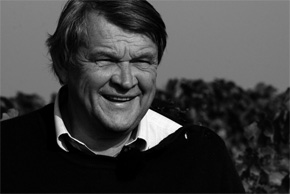 Xavier Planty
Xavier Planty
In 2011 the spring was warm and dry. Early flowering led the wine growers to believe the harvests could be three weeks early. July brought cool weather which delayed the process somewhat, followed by wet, hot weather in August. In the end, the grape harvest began 2 weeks early. The month of September provided ideal conditions with hot, sunny days and cool nights: optimal conditions for the satisfactory development of botrytis, combining splendid aroma and good acidity. The prevailing north-east wind enabled fast concentration.
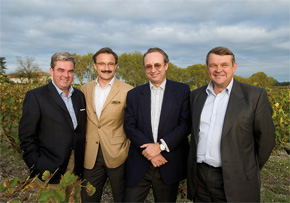 Olivier Bernard, le Comte de Neipperg, M. Peugeot et Xavier Planty
Olivier Bernard, le Comte de Neipperg, M. Peugeot et Xavier Planty 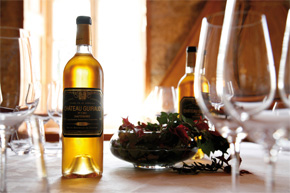
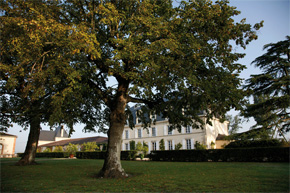
“
We carried out the first and second wave of picking on 2 September. These two high quality selections would represent 90% of the great wine. A third, fourth and even fifth wave of picking was carried out on certain plots until 10 October, which was the last day of the grape harvest at Château Guiraud. 25 days of work, with more than 100 grape pickers every day, provided us with an excellent quality but small volume of harvest: scarcely 9 hl/ha this year and 5 for the Grand vin! Unfortunately we shall never forget the hail storm on Easter Monday, the 25 April at 6 pm, with losses estimated at 40%, and up to 80% on certain plots”, Xavier Planty laments. But then he adds: “
At this time, the wines are remarkably good for tasting: concentrated, aromatic and complex, on magnificently vivacious undertones. They are striking. “2001” say my neighbours… which requires confirmation, but I am delighted with the wine I have produced, its purity and rigour, just like the wines I enjoy making. And I always hope to do better with the next vintage!”
Note that Château Guiraud, where the making of a grand Sauternes is already a vocation, has turned towards organic production out of conviction and philosophy. It has just obtained Biological Agriculture certification. It is the first and the only Sauternes Premier Grand Cru Classé to obtain this qualification, initiated back in 1995 by the director, Xavier Planty. This exemplary choice fashions the new style of the wines of the estate that are now asserting more purity, more tension and a more elegant structure.
“
The vine re-establishes itself and finds a new balance of its own accord, and so we are less interventionist. The roots gain in depth and the extraction of trace elements from the soil will be stronger and will be carried over in the expression of the wines. I am convinced that this approach, which is more respect-
ful of the vines and of biodiversity, will make it possible to enhance purity and obtain very rich wines”, Xavier Planty concludes.
Crédit Photos: F. Poincet
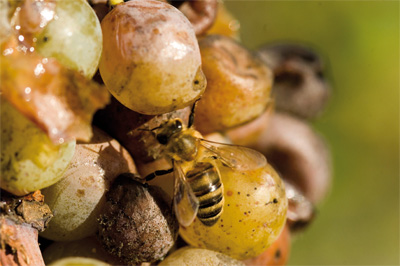
Château Guiraud
33210 Sauternes
Tél: +33 (0) 5 56 76 61 01
www.chateauguiraud.fr Château Suduiraut
Sauternes Cru Classé
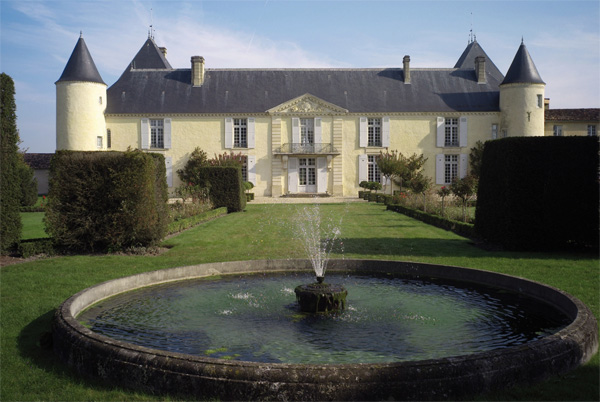
The Domaine de Suduiraut, an 1855 Cru Classé, covers a continuous area of 92 hectares of vines, characterised by a sandy-gravely soil. Christian Seely, the general director, and Pierre Montégut, the technical director, have the determination to push the quality to the extreme for this Sauternes cru. The major orientations are based on a tailored selection of plots, harvests with careful successive sorting operations (3 for the 2011 vintage), fermentation perfectly controlled barrel by barrel, and a drastic choice of batches for the creation of the vintage through skilful blending.
 Christian Seely
Christian Seely “The 2011 vintage is typified by lack of water (50% less rainfall over a 4 month period) and mild temperatures. The vine was 3 to 4 weeks early. In July, everything changed: rain, relatively cool temperatures for the season and little sunshine.
The vine gradually recovered from the preceding months of heat. During the summer, we carried out the normal work in the vineyard.

Defoliation extended from July to the beginning of September, ending with the old vines. We were very minimalist in the thinning, to encourage uniform ripening of the grapes. In the course of September, to favour the aeration of the bunches, we carried out a second round of defoliation on the plots where the growth in the rainy month of August made it necessary. As is often the case, September was very sunny and hot, promising an excellent vintage. Despite the mixed weather conditions, the 2011 blend of 93% Sémillon and 7% Sauvignon revealed itself on tasting to be fresh, fruity, with beautiful elegance, in line with the excellent years of Château Suduiraut. The aromas are long lasting, the signature of a very fine vintage, just behind the celebrated 2005, 2007 and 2009 vintages”, Pierre Montégut assures us.
A vintage full of restraint, that, once aroused, produces an expression with notes of candied citrus fruit peel, white floral notes, a touch of delicate vanilla followed by candied fruits, pineapple and mineral notes.
The wine is smoothly balanced with freshness on the palate, and a finish of sweet apricot and orange peel notes.
In the course of 2011, the Château endowed itself with an original tasting venue: The aromathèque. An entertaining and exacting approach to the aromas to be found in sweet white wines. The main aromas are ‘enclosed’ in bottles to help the tasters. A voyage for the olfactory senses and the tastebuds in black glasses for three vintages (2006, 1999 and 1989), completed by a tour of the cellars and the gardens designed by Lenôtre.
Crédit Photos: Deepix - Pierre Grenet.
Château Suduiraut
33210 Preignac
Tél.: +33 (0) 5 56 63 61 90
www.suduiraut.com Pierre Montégut
Pierre Montégut Château d’Yquem
From the most expensive bottle of white wine in the world to the birth of a very Grand 2011
A bottle of Château d’Yquem 1811 was sold for £75,000 (€85,000) to a French collector, Christian Vanneque, for his new restaurant in Bali. The bottle was sold at the London Ritz by The Antique Wine Company, who specialise in the sale of rare wines. Stephen Williams, the CEO, had high praise for the ‘legendary vintage’: “
Château d'Yquem is the best white wine in the world”, he declared. “It gains in maturity and can improve with age indefinitely. The high quantity of residual sugar, combined with the natural acidity of the grapes, act as a preserving agent. It has the capacity to age for longer than any other white wine”. To come back to more affordable considerations, the 2011 vintage of Château d’Yquem was presented by Pierre Lurton and his team in the renowned salons of the Bordeaux Chamber of Commerce and Industry during the week of En Primeur tastings.

To gain some insight into the style of the d’Yquem 2011, SommelierS International talked to Francis Mayeur, the technical director of the estate:
“
Very intense, fast harvests over a period of five weeks, in very hot, dry weather. A particularly interesting vintage in which the diversity of the terroirs of the cru allowed the indispensable control of alcohol content. The combination of the extreme richness of roast berries and less ripe grapes bursting with other flavours (varietal, fruity, floral and other precursors) contributed to the increased complexity of the array of aromas present in the wine. One last proof of the noble birth of this Grand vintage: Rapid, problem-free fermentation by natural yeasts, the powerful and pure scent of which will linger in the memory of the wine-making team for a long time to come.”
Château d’Yquem
33210 Sauternes
Tél.: +33 (0) 5 57 98 07 07
www.yquem.frGRAVES ET PESSAC-LEOGNAN
Château de Rochemorin
Interview with Vincent Cruège
"
The 2011 vintage demanded enormous technical and physical efforts”, explains Vincent Cruège, depute director of production and director of PR. "
The weather conditions were exceptional. In June the vintage was 15 days ahead of schedule. Each vineyard plot reacted differently depending on the type of soil and sub-soil. At the end of June, with the extreme heat, some plots were blocked by too much water stress, and others suffered from the heat (temperature above 40°C on 26 and 27 June); the ones on clay-limestone resisted best. The choices in managing the vineyard were primordial. We took each vineyard plot into consideration individually. Observe and adapt were the rule. In July and August, the small amount of rain that fell allowed the vine to cope with the water stress and avoid defoliation. The ripening was slow but with a particular phenomenon that gave us cause for concern – we had “harlequin” grapes, that is to say, different stages of ripening within a single bunch.

 Vincent Cruège
Vincent Cruège
I think we would have been headed for disaster if the end of August had not provided us with some very favourable ripening conditions.
Our white vines came in very healthy 2 weeks early, with conditions that were kinder to the aromatic varieties such as the Sauvignon grape.
For the reds, the use of the Tribaie sorting machine allowed us to optimise the harvesting and carry out very selective sorting.
A manual sorting process would not have been so precise. Then the extractions were conducted gently, with abundant phenolic compounds (colour, tannins). Our red wines will be in line with the 2008 reds, lots of fruit and personality. As for the quality of the whites, the spirit is the same as in 2007, 2009, 2010, with nicely pure aromas”, he concludes.
Château de Rochemorin
Chemin du Carosse
33650 MARTILLAC
www.andrelurton.com Château CarboNnieux
New president of the Graves Crus Classés
Eric Perrin, who runs the Château Carbonnieux, Graves Grand Cru Classé, in collaboration with his brother Philibert, has just taken office for three years as the President of the Graves Union des Crus Classés. He is the successor to Jean-Philippe Delmas, Director of Châteaux Haut-Brion and the Mission Haut-Brion.
Château Carbonnieux
33850 Léognan
Tél.:+33 (0) 5 57 96 56 20
www.carbonnieux.com
Eric Perrin Château Fieuzal
A superb winery for precision vintages…
At Léognan, Stephen Carrier runs the Graves Grand Cru Classé estate of 80 hectares (10 ha of which produce white) with a team of 22 employees. In 2001, the estate was taken over by an Irishman, Lochlann Quinn, a former industrialist and true wine enthusiast. The owner began to think of restructuring the production facilities back in 2007, from the organisational aspect and also from the financial point of view – by no means the least important. After three years in gestation, the project came to fruition in August 2011. The design is rational and functional, and sobriety is de rigueur. In the interior, architect Philippe Ducos has organised the production facilities with a circular barrel cellar (for 1,200 barrels), and a vatting room above the cask cellar, enabling the use of a gravitational processes for the harvest.
Wooden, concrete and stainless steel tanks, some engraved with the names of the owners’ 7 grandchildren. The sole objective is to be able to produce more and more great Fieuzal wines, both red and white, to meet the growing demand of enthusiastic customers and the Asian market.
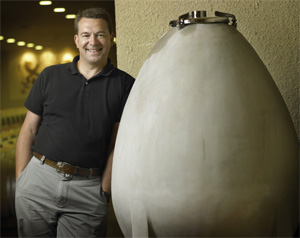 Stephen Carrier
Stephen Carrier “
It is always complicated to work simply, but everything has been designed to be functional and allow the work to be organised in such a way as to respect the grape without being ostentatious”, Stephen Carrier tells us.
Crédit photo : Hervé Lefebre / studio Twin
Château de Fieuzal
124, avenue de Mont de Marsan
33850 Léognan
Phone +33 (0) 5 56 64 77 86
www.fieuzal.com Château Haut-Brion
A superb winery for precision vintages…
In 2015, the Cultural and Tourism Wine Centre will open its doors to the general public. An ambitious leisure space, on an international scale, which will pay tribute to the shared civilisation of wine. A cultural complex, unusual in form and substance, the venue will celebrate Wine, the world cultural heritage of wine in its universality and diversity. The Dillon family and the Domaine Clarence Dillon (Château Haut-Brion, etc.), have always been involved in various charity operations and sponsorships, and are working on this project alongside the Bordeaux city council. An agreement has been signed between the company and the endowment fund set up to support the Cultural Centre.
 Son Altesse le Prince du Luxembourg
Son Altesse le Prince du Luxembourg “Through this project we are celebrating the past and at the same time looking to the future, the city of Bordeaux is consolidating its position as natural entry point to the global civilisation of wine”, declares Prince Robert of Luxembourg, CEO of the family-run company and great-grandson of founder Clarence Dillon.
Domaine Clarence Dillon SA
41, Avenue George V • 75008 Paris
Tél.: +33 (0) 1 40 73 85 85 •
www.domaineclarencedillon.com Château Malartic-Lagravière
More than a wine-grower’s vintage…
a precision vintage
For the Bonnie family, the 2011 vintage turned out to be: “a tailor-made and cool-headed vintage. The precision of the work in the vineyard was particularly decisive for obtaining the optimal ripening of the grapes, in both the whites and reds, with very satisfactory balances, but there was still a lot of selection. There were more successive sorting operations on the whites than for a classic vintage. In the reds, after rigorous selection, the extractions were slow and measured. We had to allow slow maceration to respect the raw material.
The purity of the fruit and aromas, a good tannic structure and elegant complexity in the reds; a fine, frank, straight vintage with good balance in the whites.”
Château Malartic-Lagravière
43, Avenue Mont de Marsan • BP7 • 33850 Léognan •
Tél.: +33 (0) 5 56 64 75 08 • www.domaineclarencedillon.com
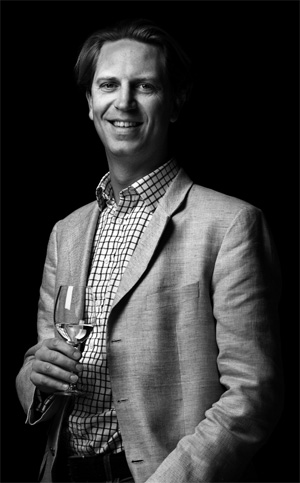 Jean-Jacques Bonnie
Jean-Jacques Bonnie Château Pape Clément
More than forty years of passion for wine… and 40 châteauX
During the En Primeur tasting week, Château Pape Clément, Graves Grand Cru Classé and Château Fombrauge, Saint-Emilion Grand cru, welcomed tasters from all over the world to sample the wines from Bernard Magrez’ estates.
The high point was on Monday, at Château Fombrauge, with a lunch orchestrated by the
Michelin-starred Chef Joël Robuchon. His team had travelled down from Paris especially for the occasion. After the tastings, SommelierS International particularly enjoyed both white and red Château Pape Cléments. We wanted to talk about the technical work on this 46-hectare Château at the gates of Bordeaux, 3 hectares of which are devoted to the production of white wine.
For eleven years, each successive vintage has been skilfully crafted. For example, the Cabernet Sauvignon and Merlot vines are managed plot by plot, from 1 to 2 hectares maximum and the soil turned over in the traditional way, using a horse-drawn plough. The grapes are harvested manually in small crates, with a first sort on the vine. The harvested grapes were separated wholly by hand. The whole grapes were then poured manually into 28 wooden vats with a small capacity to respect the quality of the grapes. 18 to 22 months maturing followed. To respect the finesse of the work, no less than 27 different types of barrels contributed added complexity to the wine.
It is in this spirit of excellence that Bernard Magrez recently added to his portfolio of estates with the acquisition of Château Romer (Sauternes Deuxième Cru Classé), Château Malleprat (Pessac-Léognan), and Château Moulin d’Ulysse, in Listrac-Médoc. He is now at the head of 40 vineyards in the World, representing more than 950 hectares of vines planted on high quality terroirs.
In Bordeaux, the ‘Cave des Découvertes’ at the château Pape Clément proposes, among 110 wines from Bernard Magrez’ vineyards, works of art from his personal collection, exhibitions and, once a month, a brunch by the fireside, not counting the classes in wine tasting, food and wine pairing and blending…
The emotion of tasting and cultural experience is open to amateur and professional.
Château Pape Clément
216, av. du Docteur Nancel Pénard
33600 Pessac
Phone. +33 (0) 5 57 86 38 38
www.pape-clement.com 
Château Chantegrive
Hélène Lévêque

At Podensac in the Graves appellation, the Lévêque family manages one of the largest estates, covering an area of almost 97 hectares: Château Chantegrive.
From 1966, this tight-knit family with, at its head, Henri Lévêque, owner of the estate and well-known broker, made painstaking improvements at every level of production. The flagship cuvee of the chateau’s range was ‘Caroline’, a dry white wine. In 2006, the Lévêque family consulted Hubert de Boüard for advice on further improving the quality of the wines, and more particularly of the reds.
When Henri died in 2007, each member of the family proudly continued to maintain this momentum, conscious of the potential of the vineyard. “
Through techniques that are new without being revolutionary, the improvement of growing methods and vinification processes, we were able to add crispness, fruit, and a gourmet feel to our red wines. Our entire warehouse has been equipped with refrigeration since 2010. We gave great thought to the choice of barrel makers, and finally selected six. In this way, we have preserved the purity of fruit in the whites and the reds”, Hélène Lévêque explains.
“
Hubert de Boüard’s precious advice and presence were beneficial, judging by the results of the 2010 En Primeurs and the quality of the 2011 tastings for our four wines. We are gradually converting the vineyard to achieve a balance of 50% white and 50% red in response to demand from our customers”, she adds. “
In 2011, 30 hectares were damaged by hail, with 6 written off completely. The business plan of a family-run company like ours requires yields of 40 hl/ha… this year we only achieved 35, in spite of the very positive comments on the whites as well as the reds.We work a lot with LDVins (also connected to our family) on all our markets, and in particular China, for they have a team there. We prefer to exercise restraint in our exports to this market, which is gradually becoming ordered.
We are also looking towards India, in spite of the high taxes. Brazil is showing a keen interest in our wines. We were able to witness this in March at the tasting in Sao Paolo organised by the UGC, which we joined in 1985”.
Once a year, Hélène Lévêque organises a Chantegrive wine-food pairing competition with the Catering Lycée Talence. A number of teams take part, sommeliers and chefs, with interesting prizes in the pot. “
Their creative talents and observations are very relevant. They are ambassadors for our four vintages” Hélène confirms.
Château Chantegrive
33720 Podensac
Phone +33 (0) 5 56 27 17 38
www.chantegrive.comMEDOC & HAUT-MEDOC
Château Lanessan
A new impetus…
In 2009, the Bouteiller estate enjoyed a new departure with the arrival of Paz Espejo, who was appointed Director by the family who own the estate. A new graphics charter has been set up to position a strong, revitalised identity. Quality goals have been set for the different Châteaus: Lanessan (45 ha), Sainte Gemme (13 ha) and the second Calèches de Lanessan wine.
“
After some 12 years of fascinating work in wine trading, my professional ambition to return to production, promoting the land, soil and know-how was realised thanks to the Bouteiller family’s trust. I came here with an outside vision, that was both technical and commercial through my past experience. A new strategy was implemented with the team. While respecting the past and the estate, it is my ambition to enhance and optimise this magnificent terroir of deep gravelly soil. I have to adjust to the authenticity and typicality that make up the elegance of Lanessan, but at the same time breathe new impetus. The work on the soil, analyses and clones have made it possible to increase the distinction and the precision of the wines from 2009, to the benefit of the vintage.
Concerning the 2011 vintage, we were very concerned. We weren’t playing Russian roulette!
For the Merlots, the basic quality is correct with a very measured extraction to obtain the velvet smoothness of the grape variety. As for the Cabernet and Petit Verdot, they are splendid and close to the level of the 2010s.
A lot of successive sorting operations were required to maintain the usual quality of our wines. The 2011 vintage, with a lot of Cabernet Sauvignon and Petit Verdot, is a beautiful Haut-Médoc signature for Château Lanessan. For drinking and pleasure, it will be a superior vintage to 2007 and even to 2008. Incidentally, we have no 2007, 2004, or 2001 left on the estate… The palate of the customer is the true reality. I really do believe that Château de Sainte Gemme could be a successful candidate for recognition as a Cru Bourgeois: rather nice terroir for amateurs seeking gourmet wines connected to the image of Medoc, at an affordable price… a very nice introduction in terms of the more complex wines in Haut-Médoc.”
Interview by Paz Espéjo – Director.
The Estate and the historical chateaus are an already established centre for wine tourism: the private museum with its collection of horse-drawn carriages, the stables at Lanessan, the superb grounds. Plans for more theme-based tourist visits and an axis on Château Lachesnaye are under consideration.
“A determination to add to the activity of wine, and the winegrowing terroir and contribute to enhancing Lanessan.” adds Paz Espejo
.
 Paz Espejo
Paz Espejo Domaine Bouteiller - Château Lanessan
33460 Cussac-Fort-Médoc
Tél.: +33 (0)5 56 58 94 80
www.lanessan.com
Château La Lagune
Interview with Caroline Frey
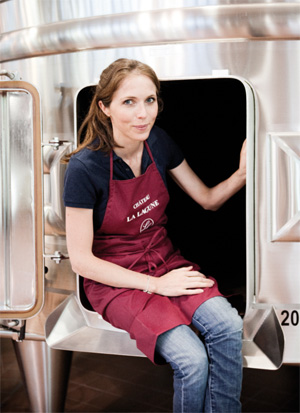
« O
n the very eve of the harvests, the vintage was still difficult to grasp. The Merlot was interesting to taste, but the Cabernet and Petit Verdot were not yet
very demonstrative. A consequence of the weather conditions, the grapes were small with rather thick skins. A non- negligible quantity of pink berries prepared us for severe sorting.
As for the flowering, the harvests were particularly early: we harvested the first Merlots on 5 September, and the last Cabernets on the 28th. This is a new record for La Lagune, almost as early as in 2003 (the harvest began on 6 September), 1982, but 1976 is still the clear winner (harvesting started on 29th August)!
On 19th September, 15 mm of rain fell on the vineyard. We did not panic, we remained very calm. Only the young Cabernet Sauvignon vine plants had been harvested and we had taken the gamble of an extra week’s ripening for the older vineyard plots. A gamble that paid off, thanks to the seven days of good weather that followed, during which the grapes came on spectacularly.
As anticipated, sorting was one of the decisive factors in the success of the vintage this year, and the X-sort (optical sorting) we have been using since 2010 enabled remarkable precision work on the small pink grapes.
The first vats were promising. The thick skins rapidly released their anthocyans, the must took on a dense colour from the very first pumping over. At the end of the alcoholic fermentation, the vats all traversed a phase of hardness that disappeared after the first days of post fermentation maceration. The wines acquired unctuousness during this last phase. Prior to running off, the levels of tannins and antho-
cyans were encouraging and the tastings confirmed these observations.
The particular and extreme conditions of this vintage did not suit all of the vineyard plots. As the line to be followed is always quality and not quantity (a yield of 31 hl/ha!), some were not included in the blend. Only the best were selected for the final blend of 60% Cabernet Sauvignon, 35% Merlot and 5% Petit Verdot, which tasted well during the En Primeurs and remains promising after a very measured maturing stage.”
Château La Lagune
81 Avenue de l’Europe
33290 Ludon-Médoc
Tél.: +33 (0) 5 57 88 82 77
www.chateau-lalagune.com Château d’Agassac
Wine and Chocolate
Once again, as for each year, the château d’Agassac opened the En primeurs tasting sessions. A Cru Bourgeois of 4 hectares on two gravelly ridges and one more gravel-sandy area, it is situated to the south of Haut-Médoc. Jean-Luc Zell presented the 2011 vintage to the press. In this atmosphere, the Bordeaux craftsman-chocolate maker Thierry Lalet from Maison Saunio also offered up his creation to the tastebuds, mingling a cocoa grand cru to the aromas of the 2011: ‘L’Agassac de Saunion n°6’.

Château d’Agassac
15, rue du Château d’Agassac
33290 Ludon-Médoc
Tél.: +33 (0) 5 57 88 15 47
www.agassac.com Château La Tour de By
News
The 42 hectares of the Château la Tour de By, on a gravelly hilltop in the Médoc appellation, are currently managed by the two grandsons of Marc Pagès: Frédéric Le Clerc and Benjamin Richer de Forges. A new Cellar Master, Pierre-Olivier Larrieu, formerly at Château d’Agassac, and a new high-performance wine storage cellar are part of the latest developments. The 2011 vintage is perfectly in line with the 2009 and 2010. Eric Boissenot, consultant oenologist for the estate and the reference on the left bank of the Garonne, more particularly for the domains of Médoc, tells us a bit about it:
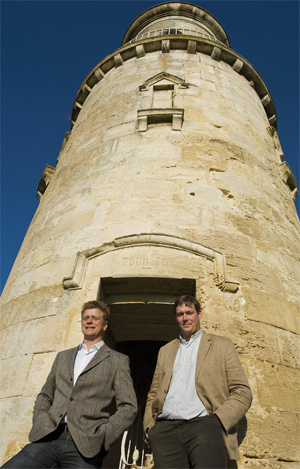 F. Le Clerc et B. Richer de Forges“It is an early vintage with completed maturities and distinctive tannins more present than in 2010, requiring unhurried extraction. More serious than demonstrative compared to 2010, it is endowed with a beautiful quality of tannins, aftertaste and complexity.”
F. Le Clerc et B. Richer de Forges“It is an early vintage with completed maturities and distinctive tannins more present than in 2010, requiring unhurried extraction. More serious than demonstrative compared to 2010, it is endowed with a beautiful quality of tannins, aftertaste and complexity.” Château La Tour de By
5, rue de la Tour de By
33340 Bégadan
Phone. +33 (0) 5 56 41 50 03
www.la-tour-de-by.com
MOULIS ET LISTRAC
Château Maucaillou
A family affair

Despite the name coined by the farmers in the Middle Ages, which has the unusual connotation in French of “bad pebble”, the Château Maucaillou, in the Moulis appellation, gained the seal of approval in 1929, when it was taken over by the Dourthe family.
While the soil may not be suitable for growing cereal crops, it is indeed favourable to the vine. From 1929 to 2006, the vineyard grew from 2.5 hectares to 76. The Dourthe family, by virtue of its experience in trading and as the owner of crus in both Bordeaux and Corbières, was able to develop a variety of activities around the Château, in particular under the strong impetus from Philippe Dourthe. The latter, while keeping a kindly, paternal eye on the business, in 2006 handed over the reigns of the Estate to his three children, who now manage the Châteaus and the Holding together. A museum of the Arts and Crafts of the vine and winemaking was set up in 1987, followed by a boutique, a wine tasting school and bed & breakfast accommodation.
Many wine critics and tasters (Ferret publishing house, journalist D. Ters and R. Parker, etc.) have often written that Château Maucaillou could have been included in the 1855 classification, but the hazards of history did not allow the wines to be presented.
This high class cru was only really created in 1875. Numerous awa




 Olivier Bernard, le Comte de Neipperg, M. Peugeot et Xavier Planty
Olivier Bernard, le Comte de Neipperg, M. Peugeot et Xavier Planty



 Christian Seely
Christian Seely 
 Pierre Montégut
Pierre Montégut

 Vincent Cruège
Vincent Cruège 
 Stephen Carrier “It is always complicated to work simply, but everything has been designed to be functional and allow the work to be organised in such a way as to respect the grape without being ostentatious”, Stephen Carrier tells us.
Stephen Carrier “It is always complicated to work simply, but everything has been designed to be functional and allow the work to be organised in such a way as to respect the grape without being ostentatious”, Stephen Carrier tells us. Son Altesse le Prince du Luxembourg
Son Altesse le Prince du Luxembourg 


 Paz Espejo
Paz Espejo

 F. Le Clerc et B. Richer de Forges
F. Le Clerc et B. Richer de Forges